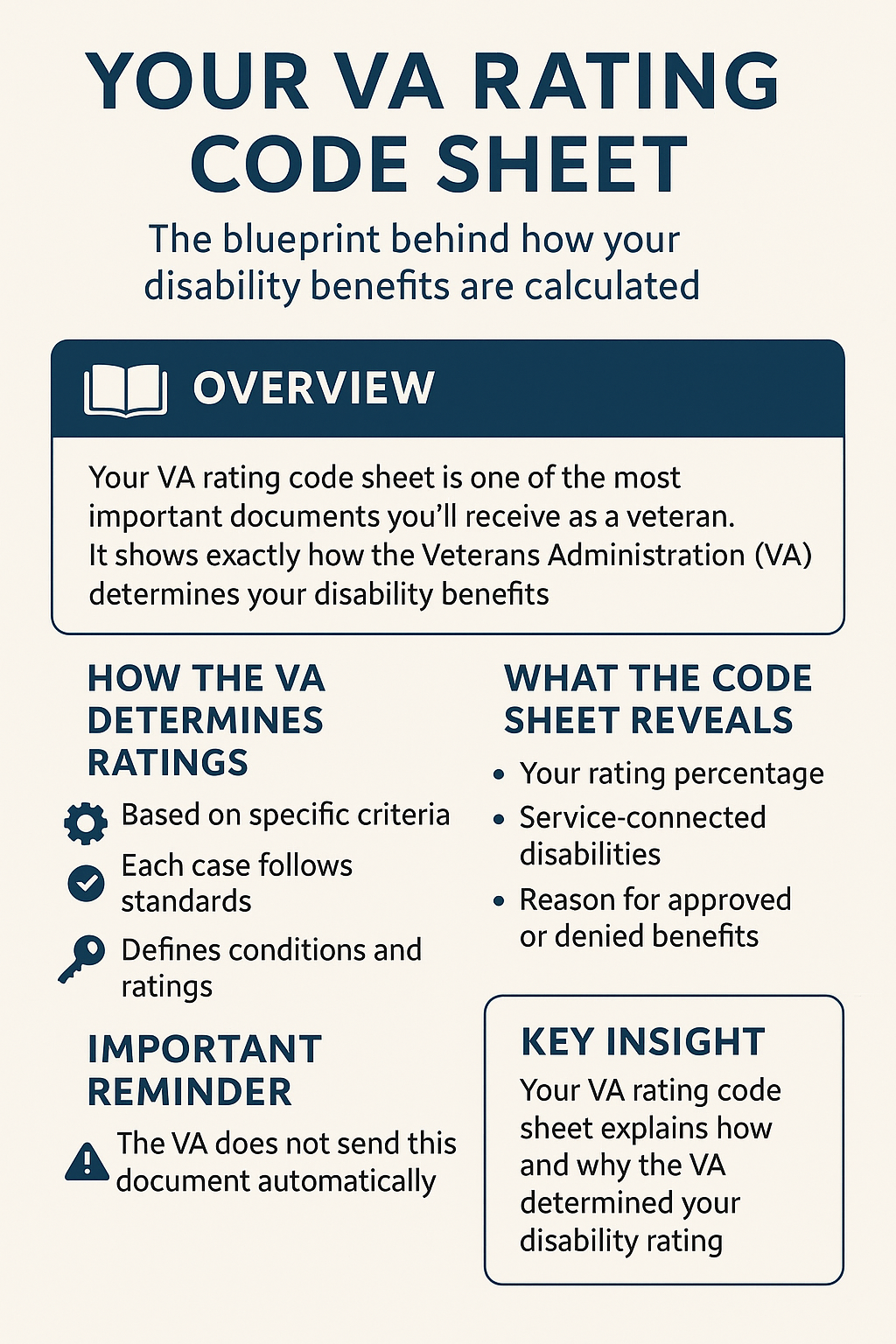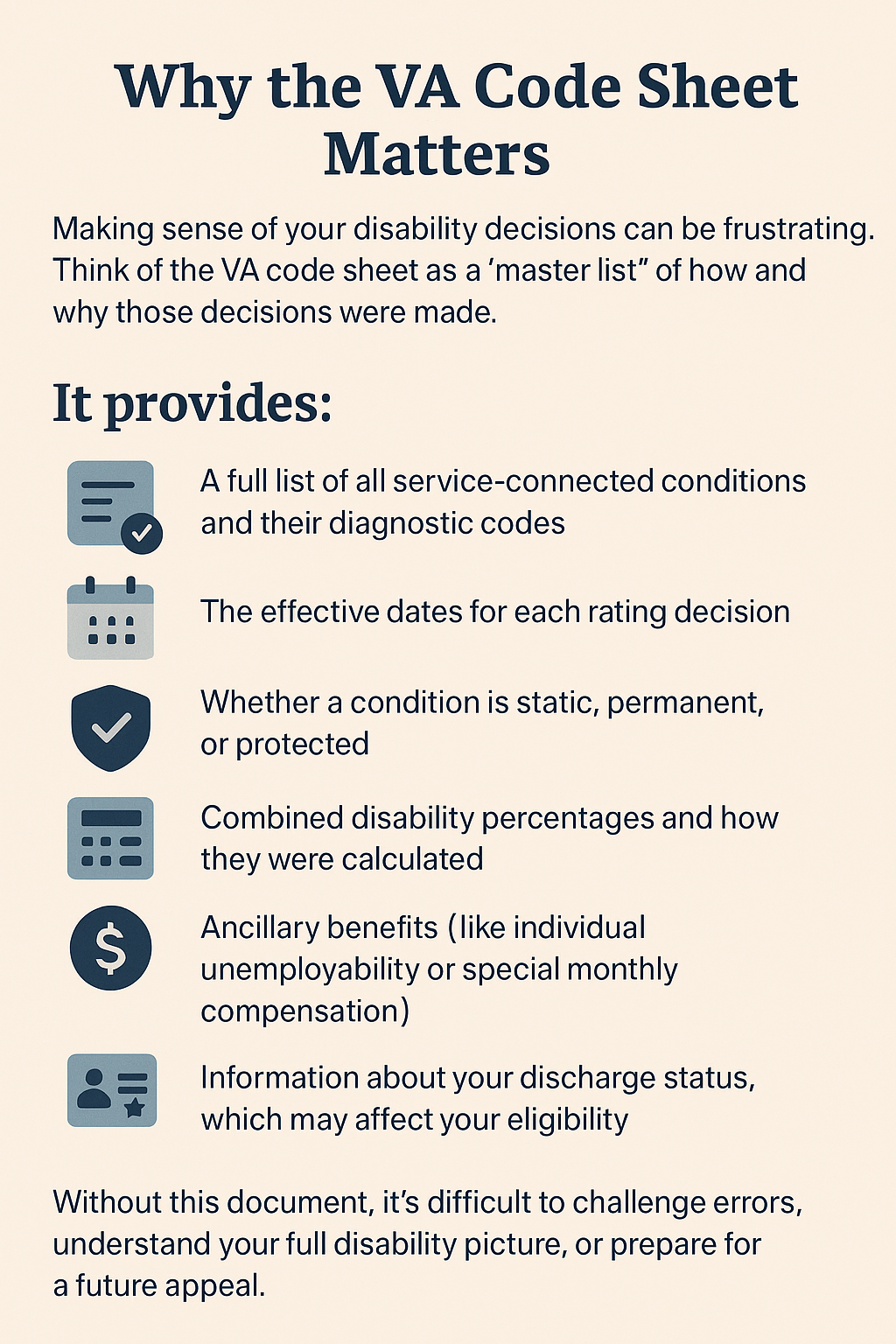Your VA rating code sheet is one of the most important documents you’ll ever receive as a veteran. Essentially, this document provides you with a blueprint on how the Veterans Administration (VA) calculates your disability benefits.

The VA uses specific criteria to determine your disability ratings, ensuring that each case is evaluated according to established standards. Due to its incredible importance, it holds the keys to your current rating, service-connected conditions, and the VA’s reasoning behind the benefits you will and will not receive. But what may come as a surprise to many veterans is that the VA doesn’t provide you with this rating code sheet automatically. It’s something you have to acquire on your own.
So, what is a VA rating code sheet really? And how do you get your hands on one? Here’s everything you need to know.
What Is a VA Rating Code Sheet?
The VA rating code sheet is an internal document that the Department of Veterans Affairs uses to summarize decisions about a veteran’s disability claims. A rating code sheet will provide a complete overview of a veteran’s service-connected disabilities. It also includes the corresponding diagnostic codes (DCs), effective dates, and the percentage rate that the VA assigns to each condition based on its severity.
The VA uses the code sheet to assign ratings and document service connection for each condition. The code sheet also lists the status of each condition, and may indicate if a disability is static or subject to future review.
This document is created and stored with every finalized rating decision. It’s not usually mailed to veterans with the award letter, which is why many have never seen it unless they specifically asked for it.
Why the VA Code Sheet Matters

Making sense of your disability decisions can be frustrating, and it is something many veterans struggle with, especially if they’ve received multiple ratings or partial denials. That said, think of the VA code sheet as a sort of “master list” of how and why those decisions were made.
It provides:
- A full list of all service-connected conditions and their diagnostic codes
- The effective dates for each rating decision
- Whether a condition is static, permanent, or protected
- Combined disability percentages and how they were calculated
- Ancillary benefits (like individual unemployability or special monthly compensation)
- Information about your discharge status, which may affect your eligibility for certain benefits
Without this document, it’s difficult to challenge errors, understand your full disability picture, or prepare for a future appeal. It is important to notice any discrepancies or errors on your code sheet, as these can directly affect your benefits and eligibility. That is why it is so important to have a VA rating code sheet and know how to read it effectively.
How to Read a VA Rating Code Sheet
Once you fully understand what a VA rating code sheet is and how it can help you, the next most important thing is being able to read it correctly. Sometimes, reading a VA rating code sheet can feel like decoding a puzzle, especially if you’ve never seen one before. But understanding its structure is key to getting what you need from it.
Some of the most common sections you’ll see in the rating code sheet include:
- List of service-connected conditions: This section includes the medical condition, diagnostic code, and assigned percentage, which are the individual ratings for each condition.
- Effective dates: These show when each disability rating began.
- Decision codes and annotations: Short codes may indicate whether a condition is considered permanent, static, or subject to future exams.
- Combined rating math: Instead of adding percentages, the VA uses a formula to calculate a combined disability rating. The combined ratings table is used to determine the overall percentage and to identify the highest rating among multiple disabilities.
- Special considerations: You might see notes about bilateral factor, unemployability, or other benefits.
The rating schedule includes diagnostic codes and evaluation criteria to ensure each condition is rated accurately according to its severity.
Key Terms and Codes Explained
Each condition on your VA rating code sheet is listed with a diagnostic code, which can be defined using a reference sheet.
Note: Not all codes are applicable to every veteran; only those relevant to your specific conditions and benefits will appear on your code sheet.
Here are some of the terms commonly found on a VA disability code sheet and what they mean:
- SC (Service Connected): Confirms the condition is related to military service.
- NSC (Not Service Connected): The condition is not linked to service.
- Static: A condition that is not expected to improve and doesn’t require re-evaluation.
- Permanent: The rating will not change in the future due to age or condition progression.
- Protected: A rating that has been in effect for 10 or 20 years and is shielded from reductions.
Example: Diagnostic Code 6602 for the respiratory system covers bronchial asthma, with ratings based on the severity of symptoms.
Some codes on the sheet may relate to pension benefits, which are awarded under specific eligibility criteria and are distinct from compensation.
For example, a code might appear as “6602 – Asthma (respiratory system) – 30%,” showing the applicable diagnostic code, condition, and assigned rating.
Common Issues Found in VA Code Sheets
Errors in the VA rating code sheet are more common than many realize. Some veterans find discrepancies that can have a major impact on their compensation amount.
Examples of this may include conditions that are rated at lower percentages than they should be, incorrect effective dates that reduce back pay, or missing or outdated diagnostic codes.
Other common issues are combined rating miscalculations, failure to include any additional disability that should be service connected, and conditions listed as non-service connected when they should be connected.
The severity of each condition directly affects the rating percentage and, in turn, the compensation amount a veteran receives.
Because the code sheet holds all the details that go into your VA rating decisions, it’s essential to review it carefully. Any corrections to the code sheet must be officially approved by the VA to ensure accuracy and compliance.
How to Request Your VA Rating Code Sheet

The VA does not automatically provide the code sheet when you receive a decision, but you can request it:
- Submit a Privacy Act request: You can ask for a copy of your VA rating code sheet by submitting a Privacy Act request in writing to your local VA regional office.
- Use the VA.gov portal: If you’ve filed a claim online, you may be able to view it via your account.
- Contact your VSO: A Veterans Service Officer (VSO) can assist you in requesting and reviewing your code sheet.
Always include your name, VA file number or Social Security number, and signature when making a request.
Using the Code Sheet in a VA Disability Appeal
Being confronted with a VA disability appeal may feel overwhelming, but utilizing the code sheet can help you sort it out.
The code sheet is essential for reviewing your disability claim, as it provides a detailed record of your ratings and the VA’s decisions. In fact, it can serve as a vital piece of evidence that you and your representative can use to your advantage. With it, you can pinpoint errors, outdated information, or overlooked conditions.
It can help strengthen your case by verifying that the VA considered all your service-connected conditions. You can also check if a condition was wrongly considered temporary or not service-connected, which can affect the long term stability of your benefits.
In some cases, appealing can help you qualify for higher ratings or additional benefits if your disability has worsened. And it reveals effective dates that may justify retroactive pay if corrected.
The code sheet can directly impact your VA disability compensation by ensuring your ratings are accurate and complete. You may also be eligible for other VA benefits based on the information in your code sheet, such as Special Monthly Compensation or additional support programs.
Whether you’re filing a Higher-Level Review, Supplemental Claim, or going to the Board of Veterans’ Appeals, the code sheet gives you clarity and leverage.
FAQs About the VA Rating Code Sheet
Because the VA rating code sheet is so important, there are a lot of things that veterans want to know about it. Here are some of the most frequently asked questions about the rating code sheet:
- What is a VA rating code sheet? It’s an internal VA document listing your service-connected conditions, disability ratings, diagnostic codes, and the logic behind your benefits.
- How do I get my code sheet? You must request it from the VA, either through a Privacy Act request or with the help of a VSO.
- Why wasn’t it sent with my decision letter? The VA doesn’t include the code sheet by default. It’s considered an internal administrative document.
- Can I use it in an appeal? Yes. The code sheet can help uncover mistakes or overlooked information that supports your appeal.
- Is the code sheet the same as the award letter? No. The award letter summarizes your decision. The code sheet shows the detailed breakdown behind that decision.
- Are injuries included on the code sheet? Yes. The code sheet lists injuries and conditions that are service-connected, including those incurred during active duty or as a result of combat or enemy actions.
- How do disability ratings affect a veteran’s ability to function? Disability ratings reflect the impact of service-connected conditions on your ability to perform daily activities and work. Higher ratings generally indicate a greater loss of ability and may result in increased benefits.
- What status information is shown on the code sheet? The code sheet displays the status of each condition, such as whether it is service-connected or non-service-connected, and whether the disability is considered static or subject to future examination. This status affects your benefits and future VA reviews.
Take Control of Your VA Benefits
Disability claims can be incredibly challenging. That’s where the VA rating code sheet comes in handy. It can be a real game-changer for veterans, providing a complete record of their benefits, conditions, and how the VA interprets their service-related health.
Receiving your code sheet and knowing how to read it will enable you to catch mistakes, safeguard your compensation, and be better prepared for any potential appeals.
Don’t wait until you’re facing a denial or a confusing decision. At Benefits.com, we are here to help you navigate the process and receive the benefits you deserve. Begin today by taking our free eligibility quiz.
 Benefits.com Advisors
Benefits.com Advisors
With expertise spanning local, state, and federal benefit programs, our team is dedicated to guiding individuals towards the perfect program tailored to their unique circumstances.
Rise to the top with Peak Benefits!
Join our Peak Benefits Newsletter for the latest news, resources, and offers on all things government benefits.




















